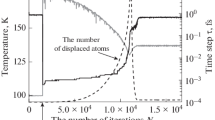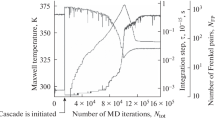Abstract
Molecular dynamics method has been applied to simulate collision cascades initiated by primary knock-on atoms (PKAs) with energy EPKA = 5, 10, 15, and 20 keV at temperatures T = 100, 300, and 600 K on the aluminum surface. A series of 48 cascades has been simulated for each pair of parameters (EPKA, T), providing a representative statistical sampling. The number of Frenkel pairs NFP, the fraction of vacancies εvac and self-interstitial atoms (SIA) εSIA in clusters of point defects, the average size of vacancy 〈Nvac〉 and self-interstitial 〈NSIA〉 clusters, the average number of vacancy 〈Yvac〉 and self-interstitial 〈YSIA〉 cluster per cascade yield, and the average time τc of cascade relaxation as a function (ЕPKA, T) have been found. The level of primary damage, 〈εvac〉, 〈εSIA〉, 〈Nvac〉, 〈NSIA〉, 〈Yvac〉 and 〈YSIA〉 have been found to be higher in surface cascades than those in displacements cascades in the bulk of material under the same simulation conditions. The morphology of surface cascades and the spatial separation of self-interstitial atoms and vacancies has been studied. Icosahedral self-interstitial clusters have been identified in displacement cascades in aluminum for the first time.













Similar content being viewed by others
REFERENCES
G. S. Was and R. S. Averback, Radiation Damage Using Ion Beams, in Comprehensive Nuclear Materials, Ed. by R. J. M. Konings (Elsevier, 2012), pp. 195–221.
R. E. Voskoboinikov, “Radiation defects in aluminum: MD simulations of collision cascades in the bulk of material,” Phys. Met. Metallogr. 120, 1–8 (2019).
R. R. Zope and Y. Mishin, “Interatomic potentials for atomistic simulations of the Ti–Al system,” Phys. Rev. B 68, 024102 (2003).
F. A. Lindemann, “The calculation of molecular vibration frequencies,” Z. Phys. 11, 609–612 (1910).
K. Nordlund and R. S. Averback, “Point defect movement and annealing in collision cascades,” Phys. Rev. B 56, 2421–2431 (1997).
R. E. Voskoboinikov, Yu. N. Osetsky, and D. J. Bacon, “Atomic-scale simulation of defect cluster formation in high-energy displacement cascades in zirconium,” ASTM STP1475, 299–314 (2006).
R. E. Voskoboinikov, “MD simulations of collision cascades in the vicinity of a screw dislocation in aluminium,” Nucl. Instr. Methods Phys. Res. B 303, 104–107 (2013).
R. E. Voskoboinikov, “Interaction of collision cascades with an isolated edge dislocation in aluminium,” Nucl. Instr. Methods Phys. Res. B 303, 125–128 (2013).
A displacement cascade initiated by an aluminum atom with an energy of 20 keV on the surface of aluminum at a temperature T = 100 K, https://youtu.be/dCXMf3tuUNE.
A displacement cascade initiated by an aluminum atom with an energy of 20 keV on the surface of aluminum at a temperature T = 300 K, https://youtu.be/ETcdA0z5O8k.
A displacement cascade initiated by an aluminum atom with an energy of 20 keV on the surface of aluminum at a temperature T = 600 K, https://youtu.be/UmaiWuHXmuE.
A displacement cascade initiated by an aluminum primary knock-on atom with an energy of 20 keV in the bulk of aluminum at a temperature T = 100 K, https://youtu.be/9DmsxklFGc4.
A displacement cascade initiated by an aluminium primary knock-on atom with an energy of 20 keV in the bulk of aluminum at a temperature T = 300 K, https://youtu.be/VfUytyxjRfg.
A displacement cascade initiated by an aluminium primary knock-on atom with an energy of 20 keV in the bulk of aluminum at a temperature T = 600 K, https://youtu.be/_a4VfQz72oQ.
R. E. Voskoboinikov, Yu. N. Osetsky, and D. J. Bacon, “Computer simulation of primary damage creation in displacement cascades in copper. I. Defect creation and cluster statistics,” J. Nucl. Mater. 377, 385–395 (2008).
B. N. Singh, D. J. Edwards, and E. Toft, “Dose dependence of microstructural evolution and mechanical properties of neutron irradiated copper and copper alloys,” J. Nucl. Mater. 238, 244–259 (1996).
L. D. Landau and E. M. Lifshitch, Theoretical Physics: Textbook, in 10 vols., Vol. 6. Hydrodynamics (Nauka, Moscow, 1988); Fluid Mechanics (Pergamon Press, 1959).
ACKNOWLEDGMENTS
The research was supported by NRC Kurchatov Institute, project #1600. Simulation software, numerical methods and point defect identification and visualisation techniques were developed under support from the Russian Foundation for Basic Research, grant 17-03-01222a. MD simulations were carried out using HPC resources of the Federal Centre for Simulation and Data Processing for Mega-science Facilities at NRC Kurchatov Institute (ministry subvention under agreement RFMEFI62117X0016), http://ckp.nrcki.ru/.
Author information
Authors and Affiliations
Corresponding author
Additional information
Translated by T. Gapontseva
Rights and permissions
About this article
Cite this article
Voskoboinikov, R.E. Radiation Defects in Aluminum. Simulation of Primary Damage in Surface Collision Cascades. Phys. Metals Metallogr. 120, 9–15 (2019). https://doi.org/10.1134/S0031918X1901006X
Received:
Accepted:
Published:
Issue Date:
DOI: https://doi.org/10.1134/S0031918X1901006X




